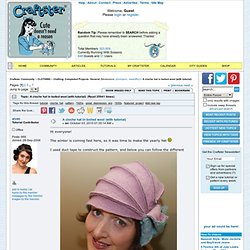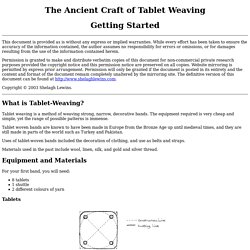

Kaleidoscope Pillows. DIY shelfs inspiration 15. A cloche hat in boiled wool (with tutorial) Hi everyone!

The winter is coming fast here, so it was time to make the yearly hat I used duct tape to construct the pattern, and below you can follow the different steps. I use a old pare of nolyn stockings and taped over them. I used a string to draw the center, front to back and side to side. Here i find the angle on the brim. After that, I taped them together. I pulled the hat of and poured corn starch inside to avoid the hat to stick. After cutting the pieces i transfered them to paper smoothing the edges.
Scott D. Anthony: Tips: 9 Ways To Be More Creative. Thorody – Contemporary Screen Printed Linen Products. LLUSTRE : So tell us how you came to form Thorody – what are your backgrounds, and how did you meet? Vicky Putler : Well, we both have fine art backgrounds, and we met on a teacher-training course at the Institute of Education – we were both planning to teach art and design. McCormick's Enterprises. Van Dykes Restorers. How to make Paper Clay. I fell in love with sculpting with paper mache during my first project five years ago.

However, I never really found a recipe that was worth the time and effort and mess that it took to get what I wanted. As a result, I used Celluclay for most projects. However, I recently stumbled upon an incredible blog called, Ultimate Paper Mache where Jonni (the artist and blogger) shares all sorts of tips, tutorials and recipes to help anyone on their way to successfully paper mache-ing.
Video tutorials on arts and crafts throughout history. Tablet Weaving. Tablet weaving is often called card weaving in the US, but "tablet weaving" has a wider acceptance.

The Ancient Craft of Tablet Weaving: Getting Started. This document is provided as is without any express or implied warranties.

While every effort has been taken to ensure the accuracy of the information contained, the author assumes no responsibility for errors or omissions, or for damages resulting from the use of the information contained herein. Permission is granted to make and distribute verbatim copies of this document for non-commercial private research purposes provided the copyright notice and this permission notice are preserved on all copies. Website mirroring is permitted by express prior arrangement. Permission will only be granted if the document is posted in its entirety and the content and format of the document remain completely unaltered by the mirroring site. The definitive version of this document can be found at Copyright © 2003 Shelagh Lewins. Scott Barry Kaufman, Ph.D.: How Our Senses Influence Creativity.
Do you focus on the forest or the trees?

Whether you have more of a global (holistic) or local (detail-oriented) processing style influences how you fundamentally perceive the world, and it is one of the most prominent factors influencing creative thought. Beyond your personality, however, situational factors also play a crucial role in what kind of processing style you will have on a moment-to-moment basis. Throughout the day, situational factors are constantly shifting your processing style without your awareness. Psychologists have identified lots of ways this operates. For instance, people are more likely to have a global processing style when they are feeling sad or thinking about the distant future. Most of these prior studies, however, have focused on the visual modality -- having people read and imagine scenarios. In each study, participants were given two tasks. As it turned out, the unconscious priming affected cognition. Most favorited all-time.
Basics of Candle Making with Step-by-Step Instructions - LoneStarCandleSupply.com. How to Make Perfume From Rose Petals. 3 Eco-Friendly Alternatives to ‘Fragrant’ Toxins Found in Your Home. I’m a bit of a girlie-girl because I like to smell nice!

Over the years I have amassed a perfume collection from old boyfriends, friends, Christmas presents and purchases I’ve made. 99% of them are ‘conventional’ fragrances from companies like Marc Jacobs, Estee Lauder, Clinique and many others. Since becoming a sustainability advisor, I discovered that many of these lovely smelling perfumes might not be the most natural thing to be spraying on my skin! According to reports released by The Environmental Working Group – a nongovernmental nonprofit based in Washington, D.C and Campaign for Safe Cosmetics, exposure to chemicals found in perfume, cosmetics and personal care products can have negative health benefits. For example, exposure to synthetic musks can have hormone-disrupting effects and phthlates, a frequent component in many fragrances used in air fresheners, detergents and cleaning supplies, can also disrupt hormonal systems. So what do you do? Notes: Related posts: Soap making.
Japanese Packaging Templates - Best Used With Card Stock or Color Paper. Origami For Everyone. Perennial_moments. Simple Pop-Ups You Can Make! Folding Trees & Kusudama Tutorial part 1 - StumbleUpon. The Japanese kusudama is a paper ball made out of multiple identical origami shapes glued together.

They were traditionally used as a ball for incense or potpourri but now we see them more for decoration or as a gift. Today I am showing you part 1 on how to make the Japanese traditional shape. There are many different patterns to make a kusudama ball but I find this the easiest pattern to get started. This is also the pattern I used to make the pink flowers on the tree in the banner. What you need for this tutorial is: 60 pieces of paper cut into squares. Below I will show you how to make the basic shape, you need to make 60 of these. Fold the bottom corner to the top. Fold the left and right corners up to the middle corner.
Fold the same points down. Open up the flaps you have just created and flatten them. Fold the top triangles towards you so they are level with the edges of the paper. Fabric Origami Workshop.